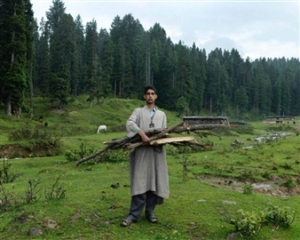Bharat Sikka: Where the Flowers Still Grow

04/01/2017 - 05/27/2017
A-1 Neeti Bagh
Nature Morte is pleased to present a new body of work by the photographer Bharat Sikka.
The state of Kashmir holds a mythic place in the mind of India. Long known as one of the world’s most beautiful mountain valleys, since the late 1980s it has become synonymous with a political and sectarian conflict which strikes at the very heart of India’s identity. Bharat Sikka first visited Kashmir in 2013, on a holiday with his family. While there, he discovered Mirza Waheed’s novel The Collaborator, which tells the story of a young Kashmiri man’s struggle with his own sense of self, buffeted by the exigencies of history and the present. This propelled Sikka to make numerous visits to Kashmir in 2014 and 2015, travelling throughout the region to photograph the people who live there, to attempt to make some sense of their dilemma through his own personal experience.
The central core of “Where the Flowers Still Grow” is comprised of portraits, predominantly young men shot alone within the colossal grandeur of an unspoiled Nature, which seems to know nothing of national borders and political rivalries. The men stare at Sikka’s camera, which stares back at them, with a plea that their representations might break through a silence, might provide the one million words necessary to explain everything. We notice one specific rock or a flowering stalk within the image that feels as if it could be light-years away from both the photographer and his subject, implicating our own existential conundrum as the viewer of the image. Where do the questions and answers lie within this image of a gaze locked within another gaze?
Having fused portraits of Kashmiri men with their landscapes, Sikka set out to record the more personal details of his visits, capturing not only objects found in homes but also dead animals, abandoned buildings, and elements of nature. These details provide a mise-en-scène for Sikka’s project, articulating a more nuanced interpretation of the region and its inhabitants. What we are ultimately left with is Sikka’s emotional response to his visits to Kashmir, the residual evidence of traumatic events, and the mute witnesses to the convulsions of history.